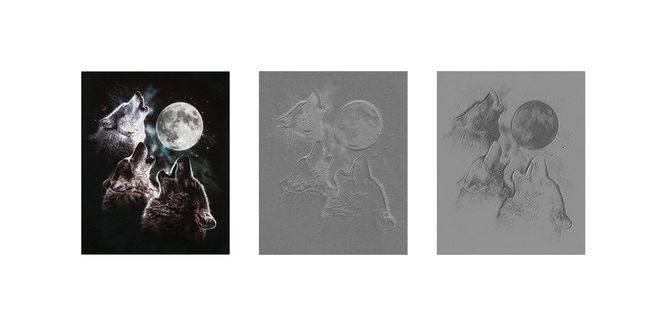theano中对图像进行convolution 运算
(1) 定义计算过程中需要的symbolic expression
1 """ 2 定义相关的symbolic experssion 3 """ 4 # convolution layer的输入,根据theano,它应该是一个4d tensor 5 input = T.tensor4(name='input') 6 # 共享权值W,它的shape为2,3,9,9 7 w_shp = (2,3,9,9);w_bound = numpy.sqrt(3*9*9) 8 W = theano.shared(numpy.asarray(rng.uniform(low= -1.0/w_bound, high = 1.0/w_bound,size=w_shp),dtype=input.dtype),name='W') 9 # 利用卷积核W对input进行卷积运算 10 conv_out = conv.conv2d(input,W) 11 # 偏执向量b 12 b_shp = (2,) # b是一个只有1个元素2的tuple 13 b = theano.shared(numpy.asarray(rng.uniform(low= -.5, high = .5,size=b_shp),dtype=input.dtype),name='b') 14 # 计算sigmoid函数 15 output = T.nnet.sigmoid(conv_out+b.dimshuffle('x',0,'x','x')) 16 # 输入输出function 17 f = theano.function([input],output)
(2)利用真实数据计算
1 """ 2 开始使用具体数值 3 """ 4 # 读入图像 5 img = Image.open('3wolfmoon.jpg', mode='r') 6 # 将输入图像存入在array中 7 img = numpy.array(img,dtype='float64')/256 8 # 对输入图像进行reshape 9 img_=img.transpose(2,0,1).reshape(1,3,639,516) 10 # 利用convolution kernel对输入图像进行卷积运算 11 filtered_img=f(img_)
(3)绘制需要显示的图像
1 """ 2 绘制图像 3 """ 4 # 显示原始图像 5 pylab.subplot(1,3,1);pylab.axis('off');pylab.imshow(img);pylab.gray() 6 # 显示filter后的图像的channel1 7 pylab.subplot(1,3,2);pylab.axis('off');pylab.imshow(filtered_img[0,0,:,:]) 8 # 显示filter后的图像的channel2 9 pylab.subplot(1,3,3);pylab.axis('off');pylab.imshow(filtered_img[0,1,:,:]) 10 # 显示 11 pylab.show()
整个代码段
1 # -*- coding: utf-8 -*- 2 3 # 导入相关的模块 4 import theano 5 from theano import tensor as T 6 from theano.tensor.nnet import conv 7 import numpy 8 import pylab 9 from PIL import Image 10 11 12 # 产生随机数的种子 13 rng = numpy.random.RandomState(23455) 14 15 """ 16 定义相关的symbolic experssion 17 """ 18 # convolution layer的输入,根据theano,它应该是一个4d tensor 19 input = T.tensor4(name='input') 20 # 共享权值W,它的shape为2,3,9,9 21 w_shp = (2,3,9,9);w_bound = numpy.sqrt(3*9*9) 22 W = theano.shared(numpy.asarray(rng.uniform(low= -1.0/w_bound, high = 1.0/w_bound,size=w_shp),dtype=input.dtype),name='W') 23 # 利用卷积核W对input进行卷积运算 24 conv_out = conv.conv2d(input,W) 25 # 偏执向量b 26 b_shp = (2,) # b是一个只有1个元素2的tuple 27 b = theano.shared(numpy.asarray(rng.uniform(low= -.5, high = .5,size=b_shp),dtype=input.dtype),name='b') 28 # 计算sigmoid函数 29 output = T.nnet.sigmoid(conv_out+b.dimshuffle('x',0,'x','x')) 30 # 输入输出function 31 f = theano.function([input],output) 32 33 """ 34 开始使用具体数值 35 """ 36 # 读入图像 37 img = Image.open('3wolfmoon.jpg', mode='r') 38 # 将输入图像存入在array中 39 img = numpy.array(img,dtype='float64')/256 40 # 对输入图像进行reshape 41 img_=img.transpose(2,0,1).reshape(1,3,639,516) 42 # 利用convolution kernel对输入图像进行卷积运算 43 filtered_img=f(img_) 44 45 """ 46 绘制图像 47 """ 48 # 显示原始图像 49 pylab.subplot(1,3,1);pylab.axis('off');pylab.imshow(img);pylab.gray() 50 # 显示filter后的图像的channel1 51 pylab.subplot(1,3,2);pylab.axis('off');pylab.imshow(filtered_img[0,0,:,:]) 52 # 显示filter后的图像的channel2 53 pylab.subplot(1,3,3);pylab.axis('off');pylab.imshow(filtered_img[0,1,:,:]) 54 # 显示 55 pylab.show()

